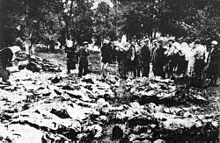Great Purge - Simple English Wikipedia, the free encyclopedia
| Great Purge | |
|---|---|
 People of Vinnytsia searching for relatives among the exhumed victims of the Vinnytsia massacre, 1943 | |
| Location | Soviet Union |
| Date | 1936–1938 |
| Target | Political opponents, Trotskyists, Red Army leadership, wealthy peasants (so called "kulaks"), ethnic minorities, religious activists and leaders |
Attack type | |
| Deaths | 950,000 to 1.2 million[1] (higher estimates overlap with at least 136,520[2] deaths in the Gulag system) |
| Perpetrators | Joseph Stalin, the NKVD (Genrikh Yagoda, Nikolai Yezhov, Lavrentiy Beria, Ivan Serov and others), Vyacheslav Molotov, Andrey Vyshinsky, Lazar Kaganovich, Kliment Voroshilov, Robert Eikhe and others |
| Motive | Elimination of political opponents,[3][4] consolidation of power.[5] |
The Great Purge or the Great Terror (Russian: Большой террор),[6] was a purge in the Soviet Union from 1936 to 1938.[7]
It was a large-scale "repression" of the more wealthy peasants (kulaks).[8] Ethnic minorities were murdered. Even members of the Communist Party, government officials, and the Red Army leadership were killed.
Everyone was watched by the police. Everyone was suspected. People were imprisoned without a fair trial. Executions were common.[9] Historians think the total number of deaths due to Stalinist repression in 1937–38 was between 950,000 to 1.2 million.[1]
The "Kulak Operation" and the targeting of national minorities made up the Great Terror. Together these two actions caused nine-tenths of the death sentences and three-fourths of Gulag prison camp sentences.
In the Western world, Robert Conquest's 1968 book The Great Terror popularized the phrase. Conquest's title was a reminder of the French Revolution time known as the Reign of Terror (French: la Terreur, "the Terror"; from June to July 1794: la Grande Terreur, 'the Great Terror').[10]
References[change | change source]
- ↑ 1.0 1.1 Ellman, Michael (2002). "Soviet Repression Statistics: some comments" (PDF). Europe-Asia Studies. 54 (7): 1151–1172. doi:10.1080/0966813022000017177. S2CID 43510161.
The best estimate that can currently be made of the number of repression deaths in 1937–38 is the range 950,000–1.2 million, i.e. about a million. This is the estimate which should be used by historians, teachers and journalists concerned with twentieth century Russian—and world—history
- ↑ Wheatcroft, Stephen G. (1999). "Victims of Stalinism and the Soviet Secret Police: the comparability and reliability of the archival data: not the last word" (PDF). Europe-Asia Studies. 51 (2): 339. doi:10.1080/09668139999056.
- ↑ Conquest, Robert 1987. Stalin and the Kirov Murder. New York: Oxford University Press. ISBN 978-0-19-505579-5.
- ↑ Conquest, Robert 2008. [1990]. The Great Terror: a reassessment. Oxford: Oxford University Press. ISBN 978-0-19-531700-8
- ↑ Brett Homkes (2004). "Certainty, probability, and Stalin's Great Party Purge". McNair Scholars Journal. 8 (1): 13.
- ↑ In Russian history, the period of the most intense purge, 1937–1938, is called Yezhovshchina (lit. 'Yezhov phenomenon'), after Nikolai Yezhov, the head of the NKVD.
- ↑ Gellately, Robert 2007. Lenin, Stalin, and Hitler: the age of social catastrophe. Knopf. ISBN 978-1-4000-4005-6.
- ↑ The word "peasant" means something like "farmer" in English.
- ↑ Figes, Orlando 2007. The Whisperers: private life in Stalin's Russia. London: Allen Lane. ISBN 978-0-7139-9702-6, pp=227–315
- ↑ Helen Rappaport (1999). Joseph Stalin: a biographical companion. ABC-CLIO. p. 110. ISBN 978-1576070840. Retrieved 29 September 2015.


 French
French Deutsch
Deutsch